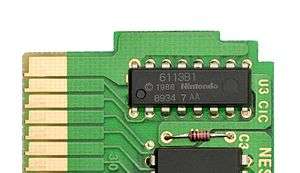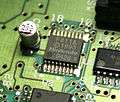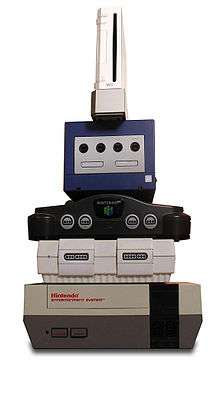CIC (Nintendo)
The Checking Integrated Circuit, or CIC, is a lockout chip designed for the Nintendo Entertainment System which had three main purposes:
- To give Nintendo complete control over the software released for the platform
- To prevent unlicensed and pirate game cartridges from running
- To facilitate regional lockout

Improved designs of the CIC chip were also used in the later Super Nintendo Entertainment System and Nintendo 64, although running an updated security program which performs additional checks.
10NES
The 10NES system is a lock-out system[1] designed for the North American and European versions of the Nintendo Entertainment System (NES) video game console. The chip is a lock[2] which can be opened by a key in the games,[3][4] designed to restrict the software that could be operated on the system.[2]
Nintendo president Hiroshi Yamauchi said in 1986, "Atari collapsed because they gave too much freedom to third-party developers and the market was swamped with rubbish games."[5] 10NES prevented third-party developers from producing games without Nintendo's approval, and provided the company with licensing fees.
Design
The system consists of two parts, a Sharp Corporation 4-bit SM590[6][7] microcontroller in the console (the "lock") that checks the inserted cartridge for authentication, and a matching chip in the game cartridge (the "key") that gives the code upon demand.[4] If the cartridge does not provide the authentication, then the CIC resets the CPU during every cycle until a game with the authorization chip is inserted.[2][3] The constant resetting of the CPU stops the console from booting up.
The program used in the NES CIC is called 10NES and was patented under U.S. Patent 4,799,635.[2] The source code is copyrighted; only Nintendo can produce the authorization chips. The patent covering the 10NES expired on January 24, 2006, although the copyright is still in effect for exact clones. Compatible clones exist that use different code.
Circumvention
Nintendo Entertainment System
Most unlicensed companies created circuits that used a voltage spike to knock the authentication unit offline.
A few unlicensed games released in Europe and Australia (such as HES games) came in the form of a dongle that would be connected to a licensed cartridge, in order to use that cartridge's CIC lockout chip for authentication. This method also worked on the SNES and was utilized by Super 3D Noah's Ark.
Tengen (Atari’s NES games subsidiary) took a different tactic: the corporation obtained a description of the code in the lockout chip from the United States Copyright Office by claiming that it was required to defend against present infringement claims in a legal case.[4] Tengen then used these documents to design their Rabbit chip, which duplicated the function of the 10NES.[4] Nintendo sued Tengen for these actions. The court found that Tengen did not violate the copyright for copying the portion of code necessary to defeat the protection with current NES consoles, but did violate the copyright for copying portions of the code not being used in the communication between the chip and console.[4] Tengen had copied this code in its entirety because future console releases could have been engineered to pick up the discrepancy. On the initial claim, the court sided with Nintendo on the issue of patent infringement, but noted that Nintendo’s patent would likely be deemed obvious as it was basically U.S. Patent 4,736,419 with the addition of a reset pin, which was at the time already commonplace in the world of electronics.[4] An eight-person jury later found that Atari did infringe.[4] While Nintendo was the winner of the initial trial, before they could actually enforce the ruling they would need to have the patent hold up under scrutiny, as well as address Tengen’s antitrust claims. Before this occurred, the sides settled.[4]
A small company called RetroZone, the first company to publish games on the NES in over a decade, uses a multi-region lockout chip for NTSC, PAL A, and PAL B called the Ciclone which was created by reverse engineering Tengen's Rabbit chip. It will allow games to be played in more than one region. It is intended to make the games playable on older hardware that uses the 10NES lockout chip and the two other regions, although the top-loading NES does not use a lockout chip. The Ciclone chip is the first lockout chip to be developed after the patent for the 10NES had expired. Since then there have been a few other open source implementations to allow the general public to reproduce multi-region CICs on AVR microcontrollers.
Because the 10NES in the model NES-001 Control Deck occasionally fails to authenticate legal cartridges, a common modification is to disable the chip entirely by cutting pin 4 on the Control Deck's internal 10NES lockout chip.
Super Nintendo Entertainment System
Towards the end of the SNES lifespan, the CIC was cloned and used in pirate games. Often, the clone CIC chip would be rebranded with an inconspicuous brand/part number to prevent detection by authorities. Alternatively the aforementioned method of using a licensed game's CIC chip was possible.
Super Famicom
 CIC chip on SFC mainboard
CIC chip on SFC mainboard
(F411) CIC chip on SFC cartridge
CIC chip on SFC cartridge
(D411)
References
- U.S. Court of Appeals, Federal Circuit. "Atari Games Corp. v. Nintendo of America Inc.." Digital Law Online. Accessed on April 19, 2006.
- US patent 4799635, Nakagawa Katsuya, "System for determining authenticity of an external memory used in an information processing apparatus", assigned to Nintendo Co., ltd
- US patent 5004232, Wong, John J & Lui, Paul S, "Computer game cartridge security circuit", assigned to Macronix, Inc.
- Patent Arcade "Case: Atari v. Nintendo (N.D. Cal. 1993) [C,P] Atari Games Corp. v. Nintendo of America, Inc. 30 U.S.P.Q.2d 1401 (N.D. Cal. 1993) (Atari II)." Accessed on July 12, 2006
- Takiff, Jonathan (June 20, 1986). "Video Games Gain In Japan, Are Due For Assault On U.S." The Vindicator. p. 2. Retrieved 10 April 2012.
- Segher (January 17, 2010). "The weird and wonderful CIC". Hackmii. Retrieved May 18, 2010.
- Sharp Microcomputers Data Book (PDF). September 1990. pp. 26–34. Retrieved May 8, 2017.
External links
- Kevin Horton. "The Infamous Lockout Chip." Accessed on August 22, 2010.
- "Ed Logg (Atari) interview" discussing Tengen lock chip
- Ciclone lockout chip Information from RetroZone
- Disabling the NES "Lockout Chip ( 2009-04-29) (rev. 0.5 26-Dec-97)
- Source code to compatible key
